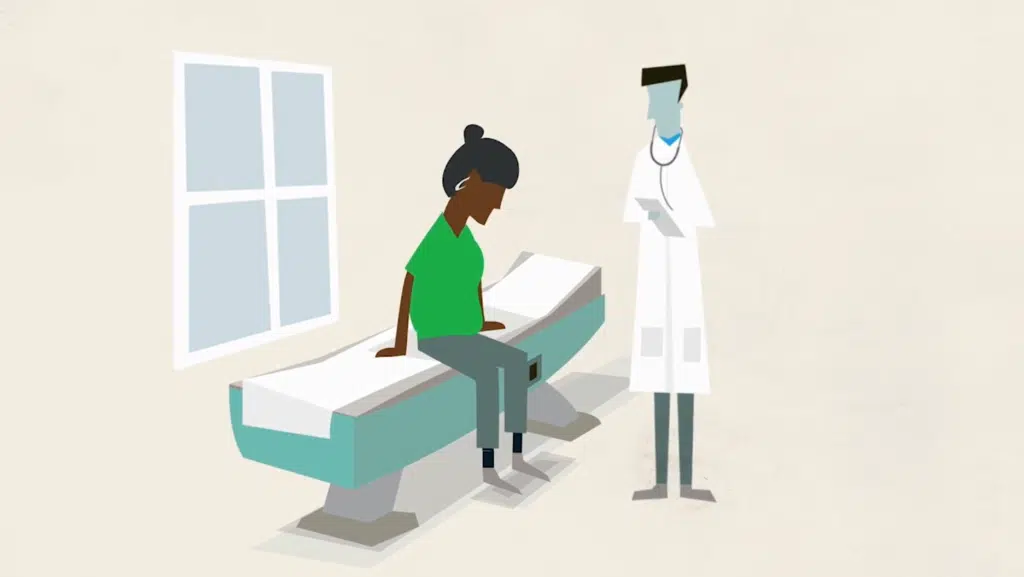Patient-centered healthcare focuses on each patient as an individual with their own needs and desired health outcomes. Busy healthcare workers may struggle to keep that focus. It’s not always easy to remember that the daily routines of your work can be new and even scary to the people in your care. That’s why more hospitals, medical schools, and care centers are investing in patient journey videos.
What are patient journey videos?
Patient journey videos tell the story of what it’s like to live with a condition or experience care from the patient’s point of view. The intended audience is usually physicians, nurses, pharmacists, and healthcare workers. Caregivers and patients might also use patient journey videos to understand what they might experience after a diagnosis or during care.
They’re different from healthcare education videos or mechanism of action videos because they’re more story focused. Instead of explaining how something works, they explain how something feels.
“Dramatizing the patient story helps bring out a more empathetic response in healthcare providers. That’s what animation can do, because we’re storytellers,” said IdeaRocket Founder and CEO William Gadea.
What patient journey videos can do
When patient journey videos tell a compelling story, they equip your healthcare team to better support patients and improve overall patient care. Patient journey videos promote patient-centered healthcare by:
1. Building empathy between care providers and patients
Patient-centered care is all about recognizing the patient as an individual, but that can be hard to do when you see dozens of patients a day. It’s even harder when you don’t know that patient’s full story. Patient journey videos can help fill in the gaps, so healthcare workers can more easily understand where a patient is coming from.
2. Giving healthcare workers the tools to improve treatment adherence
When physicians, nurses and pharmacists understand what the patient is really experiencing, they’re better equipped to help the patient overcome obstacles that might prevent treatment adherence. In the video below, Janet is so overwhelmed by the gravity of her diagnosis that she barely hears what her doctor says to her. She ends up getting information from less reputable sources, and her treatment plan suffers.
If her doctor had understood this, he could have adjusted his approach, offered more detailed resources, or found other ways to communicate. While patient journey videos won’t directly influence treatment adherence, they can give medical professionals the perspective they need to achieve that goal.
3. Showing healthcare workers the big picture
As healthcare becomes more specialized, patient journey videos become even more important. They help healthcare workers see the big picture. When you’re meeting a patient for the first time, it can be hard to remember that whatever problem you’re addressing is their daily reality. Videos remind medical professionals of the overall patient experience, so they’re better equipped to address the individual patient’s needs.
Some organizations have also started to develop caregiver journey videos, which show the patient journey from the perspective of family, friends, or non-medical caregivers. These videos provide even more context and allow healthcare workers to empathize with the people who care for their patients daily. Better understanding can turn into more favorable outcomes for patients.
Animated vs. Live-Action Patient Journey Videos
Patient journey videos can be live action or animated. Which one you choose depends on your needs, goals, budget and timeline. Both can fulfill the goals of building empathy, improving treatment adherence, and bringing the big picture into focus.
Live-action lets you put a real face on the condition. You don’t have to design characters, but you do have to cast actors or find real patients willing to tell their stories on camera. Coordinating live-action recording can be complicated and time consuming.
Animation lets you more easily dramatize every step of the patient journey. It does involve character design, but you won’t need sets or camera crews. Animated videos tend to have a longer shelf life because they’re more symbolic. Plus, they’re easier to update if things change or you want to insert a new step into the journey.
Or you might choose a hybrid approach. “We’re currently working on a video for a major pharmaceutical company that combines real life interviews with patients and animated dramatizations on-screen,” says Gadea. It is an approach that combines authenticity and greater graphical freedom.
How to Make An Effective Patient Journey Video
Whatever approach you use, the first step to creating an effective patient journey video remains the same. Start by talking to real patients. Gather their stories and work to understand their fears, questions, and concerns. Ask them:
- When and how were they diagnosed or introduced to this treatment?
- What do they wish they knew when they started?
- How did healthcare professionals make them feel supported, or not?
- How did family and friends help or hinder their care?
- What were the outcomes?
You may find patients who are willing to have their stories recorded. Others may be comfortable sharing, but not want to appear on video. You can still use these stories to inform the composite story you tell in your video.
Once you’ve collected the thoughts, feelings, and fears of real patients, your video creation partner can help you shape those into a compelling composite story. Expect this process to be more involved than your standard commercial. Getting the story right takes some work, but it’s worth it. You’ll measure the result in empathy and patient satisfaction.
As storytellers and video creation experts, the team at IdeaRocket can help you make an effective patient journey video. Contact us today.






